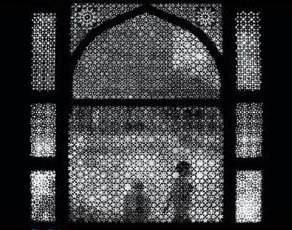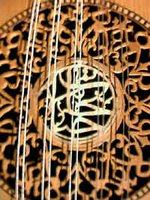

The ghazal and sonnet have often been compared. They are both the representative poetical forms of their cultures. Did one influence the other? This is a chicken and the egg story and a game more for literary showdowns between Eastern and Western scholars to point out cultural superiority. Meanwhile, let’s have a quick look at both.
The Ghazal: The older of the two forms is the ghazal. They were first written down in Arabic during the Umayyad period (661-750 A.D.) when nomadic existence started moving toward a more settled and sophisticated urban lifestyle. The very first ghazals, however, were probably pre-Islamic tribal oral song-poetry developed as a form of competitive street ‘slam poetry’. With the spread of Islam, the ghazal entered Persian, Turkish and other literary cultures. It began to acquire more literary refinement as the warm-up preface in praise of a noble person or patron at the beginning of a heroic ode or love story (qasida, is also an Arabic form). Gradually, the ghazal was cultivated as a short literary form (usually five to fifteen couplets) in its own right, specializing in amorous subjects.

The Italian Sonnet: The first sonnet was written by medieval lawyer and poet Giacomo da Lentino of Italy in the year 1230 AD. Later Franscisco Petrarch (1304-1374) wrote sonnets whose form was copied and introduced about 200 years later into the English language by Sir Thomas Wyatt (1503-1542) ‘Sonnet’ means little song. They were and still are strongly associated with romantic love. Petrarch wrote them to his wife, Dante dedicated his to Beatrice. They are structured poems of fourteen lines. . The Italian, or Petrarchan sonnet’s fourteen lines are broken into an octave (or octet, 8 lines), which usually rhymes abbaabba, but which may sometimes be abbacddc or even (rarely) abababab; and a sestet (6 lines), which may rhyme efgefg or efefef, or any of the multiple variations possible using only two or three rhyme-sounds.
The English Sonnet: The English or Shakespearean sonnet, developed first by Henry Howard, Earl of Surrey (1517-1547) and made famous by William Shakespeare, consists of three quatrains and a couplet--that is, it rhymes abab cdcd efef gg. They are divided into two parts and ‘octave’ of eight lines and a ‘sextet’ of 6 lines. The English sonnets are arranged as three quatrains (stanzas of four lines) followed by a couplet (a two-lined stanza). The traditional rhyme scheme used for English sonnets is abab, cdcd, efef, gg. Each line traditionally is written in iambic pentameter– that is, a line of ten syllables that follows the unstressed/stressed rhythm pattern. Beyond the stanzaic structure, the rhyme scheme, and the iambic pentameter, an English sonnet must present a conflict and resolve it in the couplet. Each quatrain can present a different point of view about the problem. The couplet at the end is for the poet's final thoughts on the subject. The conclusion can be clever or poignant. It may be a surprise twist.
Sonnet and Ghazal Compared: The two genres share brevity. Indeed the Persian ghazal of Hafiz is generally 14 lines long as is the sonnet. Both are basically romantic and have an introspective sensibility. Of course, the over-riding difference is that a sonnet is a lyrically narrative and a ghazal is a group of linked couplets. According to Shamsur Rahman Faruqi and Frances W. Pritchett:
The ghazal presents a blend of unity and autonomy that often seems paradoxical to Westerners. Formally speaking, the ghazal can be said to be unified: since its verses share meter, rhyme, and usually end-refrain as well, it has a powerful symmetry and cohesion. In terms of content, however, each two-line verse is an independent, free-standing poem, making its own effect with its own internal resources. Except for rare and special cases, there is no narrative or logical “flow” from one verse to the next; if the verses were rearranged, or one or two removed, usually the action would not even be detectable. While such treatment would fatally damage a sonnet, it would have little or no effect on most ghazals.
Sonnet, Son of Ghazal? Iranian scholar Iraj Bashiri has speculated on whether the older ghazal form had any influence in the development of the sonnet. What were the links and ties between the East and the West during the time of Hafiz or earlier? Italy was a world trade centre, and almost all Islamic waterways had Italian ports as their foci. Many Eastern literary works, such as The One Thousand and One Nights and The Seven Sages, found their way to the West before this time. The former, indeed, constitutes the framing story of Chaucer's Canterbury Tales, believed to have been written in 1387, within Hafiz' lifetime. Other works of Chaucer may produce still stronger links between Eastern and Western literatures at that time, The Parliament of Fowls being a case in point. Bashiri goes on to say:

But a theory cannot be based simply on speculation and mere conjectures. Structurally, there are many components of the ghazal, in its perfected form, that correspond to the model introduced by Petrarch, and later developed into the Petrarchian and Shakespearean sonnets. To begin with, the seven-bayt ghazal corresponds exactly with the fourteen lines, or seven couplets, of the sonnet. Beyond these lie the division of the sonnet into an octave and a sestet, which also includes a change of attitude by the poet at the beginning of the sestet in Petrarchian sonnets. These similarities between the ghazal and the sonnet are more than coincidence. Wyatt, definitely a Petrarchan sonnet writer, can be distinguished for his use of the unfamiliar quantitative meter in English poetry; the reason for his using such meter may be the source or sources on which he models his poems.
 Another point of similarity between these two most celebrated poetical forms of their cultures is that they are essentially linked to music. The Western sonnet along with sister forms like the rondeau and the villanelle were part of the courtly troubadour tradition and were initially performance pieces to be sung or recited to music. Western poetical forms have moved from the oral tradition to the written one and thus the the sonnet’s sonorous roots are less evident to us.
Another point of similarity between these two most celebrated poetical forms of their cultures is that they are essentially linked to music. The Western sonnet along with sister forms like the rondeau and the villanelle were part of the courtly troubadour tradition and were initially performance pieces to be sung or recited to music. Western poetical forms have moved from the oral tradition to the written one and thus the the sonnet’s sonorous roots are less evident to us.




